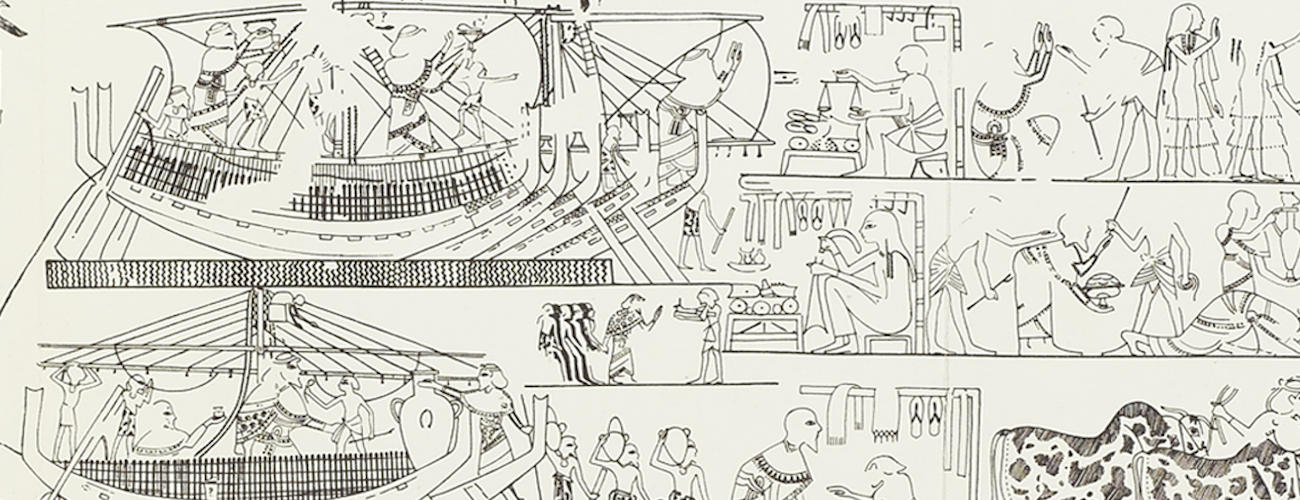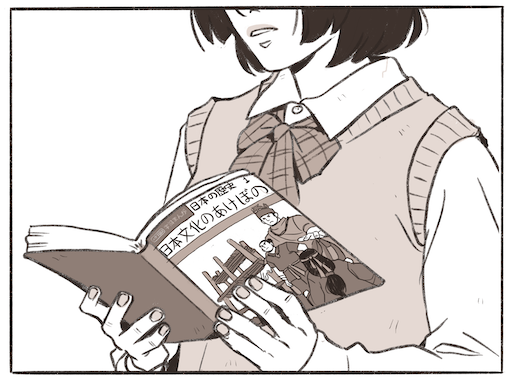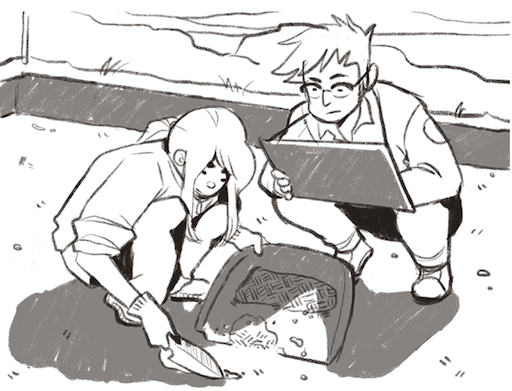Archaeology and Comics: First Response

Marginalization and Manga
While acknowledging the necessity of a critical examination of Black archaeologists in Western comics, as highlighted by Przystupa in her recent contribution to Epoiesen (2024), I’d like to focus on the broader topic of fostering a more inclusive narrative at the intersection of archaeology and comics. More specifically, I would like to extend her brief discussion of the lack of engagement of manga and Japanese archaeology in Western research. Archaeological themes and archaeologists have been consistently present in manga since the early stages of its postwar boom (Hutchinson 2013). Manga has also served as a medium for disseminating archaeological knowledge in history textbooks. The recent surge in interest in archaeology by the public has led to online platforms offering additional spaces for engaging with prehistory through comics, like @toora_shimizu on X. In other words, there is a wealth of sources to engage in the conversation on archaeology and comics, and I would like to reflect on why they have been ignored in the West.

Fig. 1. Reading prehistory in Japan, art by ama.
Manga has a rich history of representation of archaeologists that has developed over the decades. Western tropes of older men clad in safari gear and pith helmets dominated early postwar depictions (Sakurai 2016), attesting to the reach of Western archaeology. More conventional portraits of archaeologists emerged across various genres of manga as rescue archaeology gained visibility over the next few decades (Sakurai 2017) and the media popularized discoveries like Yoshinogari (Mizoguchi 2004). From Robin in One Piece to the biracial Taichi Hiraga-Keaton of Master Keaton: ReMaster, there is a greater diversity of archaeologists in manga at present (Sakurai 2019). Due to the vibrant Japanese self-publishing and small press, indie manga also features archaeologists telling their own stories, such as Imai Shoko, who published an archaeological work manual manga featuring her experiences in the field as a volunteer (2021).
Despite these developments, I believe fewer Western readers are equipped to recognize Japanese archaeology and archaeologists represented on the pages unless specifically coded in borrowed Western tropes or directly stated. This observation stems from over a decade of experience working at conventions as well as a Japanese archaeological field school. Firstly, many translations don’t provide the cultural and historical background for Japanese archaeology in manga. As part of an outreach program at a museum in the United States, I hosted panels at a local anime convention that explored aspects of Japanese history present in anime and manga. Most participants were unfamiliar with Digimon’s ties to the Jomon period or Sailor Moon’s appropriation of archaeological artifacts from the Kofun period. Secondly, overseas field school participants, scholars and students alike, have demonstrated limited knowledge of Japanese prehistory and the practices of Japanese archaeology, insofar that some references in manga would be difficult for even specialists to identify.

Fig. 2. Presenting archaeological influences in anime and art, art by ama.
The historical marginalization of the archaeology of Asia from the traditional Western focus has contributed to this gap in knowledge (Scarre 2004). This, along with language barriers that limit accessibility to Japanese research and the insularity of the discipline within Japan, has created an unfamiliarity with Japanese archaeology among manga readers and archaeologists in the West. As someone working in Japanese archaeology, I have encountered these boundaries repeatedly, and in one specific case, within the comics community. A pitch to turn my research on Japanese archaeology into a graphic novel was declined because Japan was "the weakest part of the project." Japanese archaeology was considered irrelevant to North American academia and general readers(Fig. 1).

Fig. 3. Concept art for a graphic novel based on an excavation in Japan (2017) by ama.
I second Przystupa’s call for the inclusion of diverse perspectives and voices in archaeology. I would add that fostering an inclusive environment within archaeology not only involves the inclusion of diverse perspectives and experiences but also necessitates recognizing marginalized forms of archaeology. We must critically examine the narratives that Western archaeology prioritizes in classrooms and media. Despite a rich history of Japanese archaeology and its representation in manga, their contributions to archaeology and comics are largely absent from global conversations. Engaging manga promises to broaden our understanding of the past and expand the discussion of the representation of archaeology in comics. Conversely, a more critical approach to the representation of archaeologists in manga can contribute to discussions of inclusivity in Japanese archaeology. As with any good cliffhanger, this conversation is to be continued…
References Cited
Gomes, Amanda (2018). Time Traveling through Anime- An Introduction to Japanese History. Powerpoint presentation. Morikami Museum and Japanese Gardens Outreach Program.
Hutchinson, Rachael (2013). ‘Sabotaging the Rising Sun: representing history in Tezuka Osamu’s Phoenix,’ in Rosenbaum, R. ed. Manga and the representation of Japanese history. London: Routledge.
Imai, Shoko (2021). Manga de wakaru kokogaku iseki hakutsu Work Manual. Tokyo: Sogensha Co., Ltd.
Mizoguchi, Koji (2007). “Identity, Modernity, and Archaeology: The Case of Japan”. In Meskell, L. and Preucel, R.W. eds. A Companion to Social Archaeology. Malden: Blackwell Publishing Ltd.
Sakurai, Junya (2016). Images of Archaeologists in Japanese Comics (1): the 1950s-1970s. Bulletin of Policy and Management, Shobi University 28, pp. 101-110.
Sakurai, Junya. (2017). Images of Archaeologists in Japanese Comics (2): the 1980s. Bulletin of Policy and Management, Shobi University 29, pp. 87-98.
Sakurai, Junya. (2019). Images of Archaeologists in Japanese Comics (4): the 2000s. Bulletin of Policy and Management, Shobi University 32, pp. 103-122.
Scarre, Chris (2004). “The Western world view in archaeological atlases”. In Gathercole, P.W. and Lowenthal, D. eds. _ Politics of the Past_. Hoboken: Taylor and Francis
